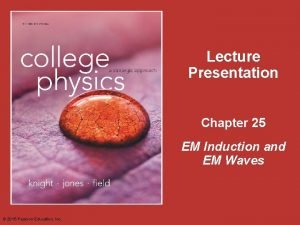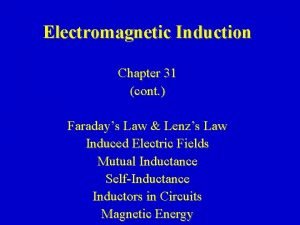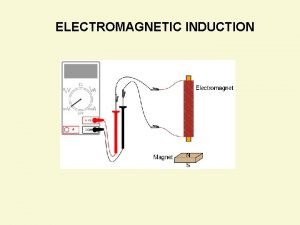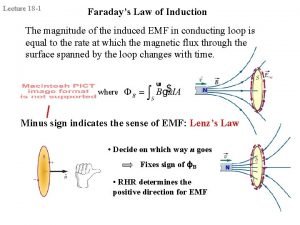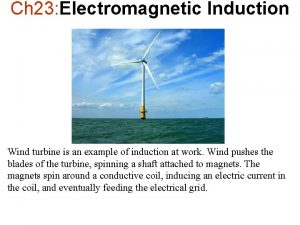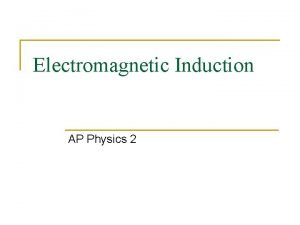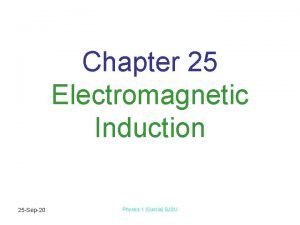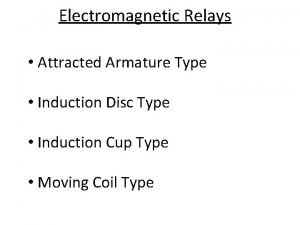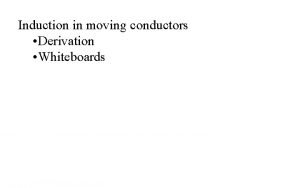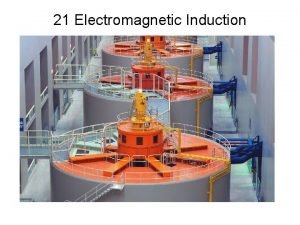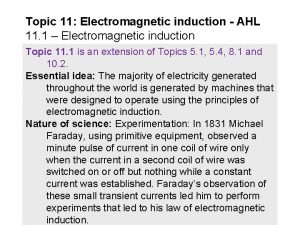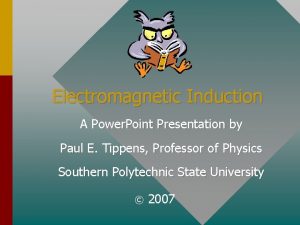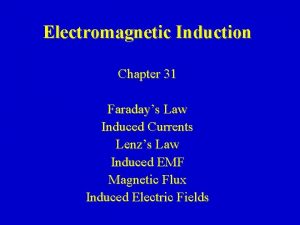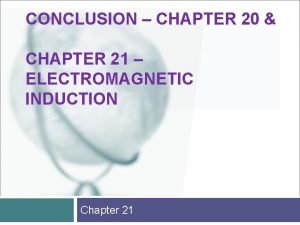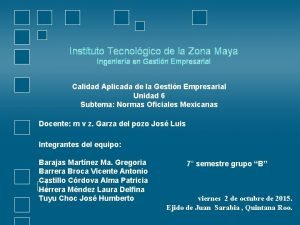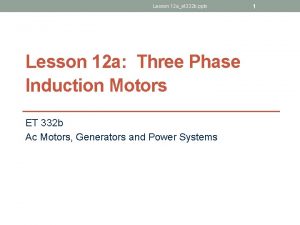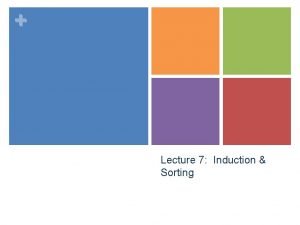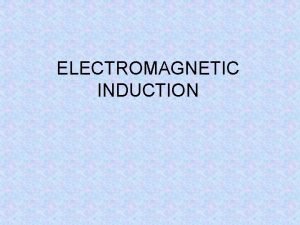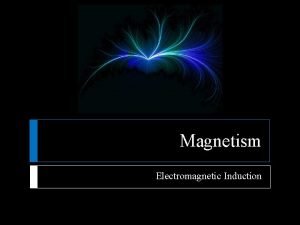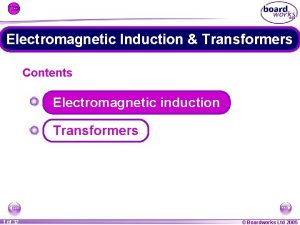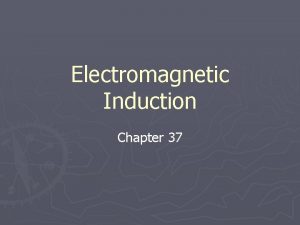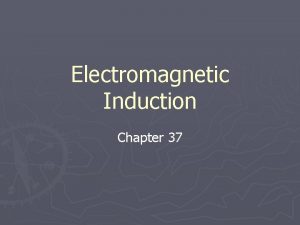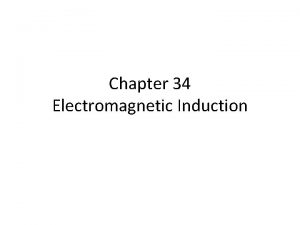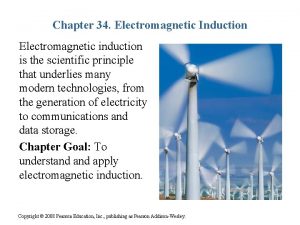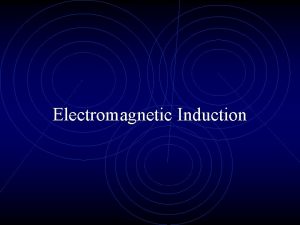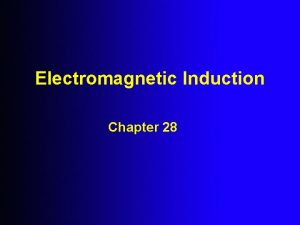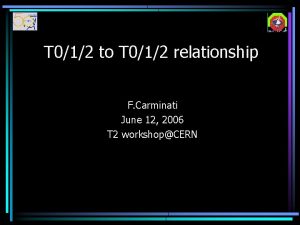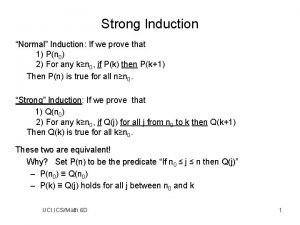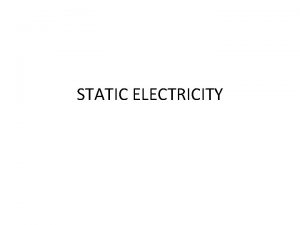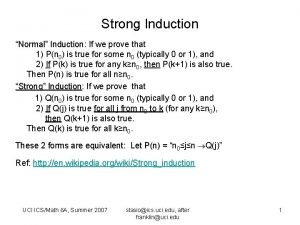Electromagnetic Induction 012 11000 r 1 04 Electromagnetic



































- Slides: 35

Electromagnetic Induction 012 -11000 r 1. 04

Electromagnetic Induction Introduction Journals and Snapshots The Snapshot button is used to capture the screen. The Journal is where snapshots are stored and viewed. The Share button is used to export or print your journal to turn in your work. Each page of this lab that contains the symbol should be inserted into your journal. After completing a lab page with the snapshot symbol, tap (in the upper right corner) to insert the page into your journal. Note: You may want to take a snapshot of the first page of this lab as a cover page for your journal.

Electromagnetic Induction Lab Challenge You can send electricity through a conducting wire to make a magnetic field. Is the reverse possible? Can you use a magnet and a conducting wire to make electricity?

Electromagnetic Induction Background Michael Faraday (1791 - 1867) discovered a relationship between a changing magnetic flux Φ, and the potential within a conductor ε: Known as Faraday's Law, this relationship is defined by two key elements, the number of turns in a coil N, and the change in magnetic flux Φ. Magnetic flux is related to the strength of the magnetic field, the area enclosed by the wire loop and the angle between them. Because of the geometry of our experimental setup, we can say that the flux is proportional to the strength of the magnetic field.

Electromagnetic Induction Safety Be careful with magnets. Strong magnets can disrupt electronic devices and severely pinch any skin that comes between them.

Electromagnetic Induction Materials and Equipment Collect all of these materials before beginning the lab. • • • Voltage Probe 3 Magnets of different strength 200 turn coil 400 turn coil 800 turn coil Lab Stand (not shown) Three fingered clamp No Bounce pad (optional) Paper, tape and a pen

Electromagnetic Induction Sequencing Challenge A. Connect the Voltage Probe to the SPARK Science Learning System. B. Drop the magnet through the coil, then stop data collection. Hint: This step is used twice. C. Compare the Voltage produced by the 200 turn coil to that produced by the 400 turn coil on the graph. D. Remove the 200 turn coil and replace it with the 400 turn coil. The steps to the left are part of the procedure for this lab activity. They are not in the right order. Determine the correct sequence of the steps, then take a snapshot of this page.

Electromagnetic Induction Part 1 - As the Coil Turns In the first part of this lab, we determine if passing a magnet through a coil of wire gives rise to a voltage (or electromotive force), and secondly, whether the number of turns in the coil N has any effect on the amount of voltage as predicted in Faraday's equation. Note: For the best comparison, always be sure to use the same orientation of the magnet when dropping it through the coil.

Electromagnetic Induction Prediction Try to predict the shape of the Voltage versus Time curve using the Prediction Tool*, then take a snapshot of this page. *To Draw a Prediction: 1. Tap to open the tool palette. 2. Tap then use your finger to draw your prediction. 3. Tap when finished. 4. If you make a mistake, tap to clear your prediction.

Electromagnetic Induction Setup 1. Mount the 200 turn coil to the lab stand using the three finger clamp, approximately 40 cm above the lab table. 2. Connect the voltage probe to the coil. 3. Connect the voltage probe to your SPARK Science Learning System. 4. If you are using a pad place it below the coil.

Electromagnetic Induction Collect Data 1. Hold the magnet just above the coil opening. 2. Tap to start data collection. 3. Drop the magnet through the coil then quickly tap to stop data collection (~1 sec). 4. Switch coils. 5. Repeat steps 1 through 4 for each coil, dropping the magnet from the same height each time.

Electromagnetic Induction Analysis 1. Adjust the scale of the graph to fit data for all three runs, then indicate in the text box below which run corresponds to which # turn coil.

Electromagnetic Induction Analysis 2. Briefly describe one of the major differences between runs in the text box below.

Electromagnetic Induction Analysis Electromagnetic Induction 3. Describe the relationship between the number of turns in the coils and the peak voltages you observed. Take a snapshot of the page after entering your response.

Electromagnetic Induction Part 2 - More Magnet The second part of Faraday's equation refers to the amount of change in magnetic flux. From our observations of magnets, different types of material produce different strengths of magnetic field. Try at least two magnets of different strengths to see if the strength of the magnet makes a difference. Use only one of the coils and drop the magnets from the same height each time.

Electromagnetic Induction Part 2 - More Magnet Before proceeding to data collection, first delete* all of the data currently in this SPARKlab. Make certain you have already snapshot the data on pages 12 and 13 before deleting. *To Delete all Data Runs: 1. Tap to open the Experiment Tools screen. 2. Tap MANAGE RUNS. 3. Tap DELETE ALL RUNS. 4. When asked to confirm deletion, tap YES. 5. Tap OK to return to the SPARKlab.

Electromagnetic Induction Collect Data 1. Hold the magnet just above the coil opening. 2. Tap to start data collection. 3. Drop the magnet through the coil then quickly tap to stop data collection (~1 sec). 4. Switch magnets. 5. Repeat steps 1 through 4 for each magnet, dropping the magnet from the same height each time.

Electromagnetic Induction Analysis 4. Adjust the scale of the graph to fit data for the last three runs, then indicate in the text box below which run corresponds to which magnet.

Electromagnetic Induction Analysis 5. Briefly describe one of the major differences between the last three runs in the text box below.

Electromagnetic Induction Analysis 6. Describe the relationship between the strength of magnet used and the peak voltages you observed. Take a snapshot of the page after entering your response.

Electromagnetic Induction Part 3 - The Faster the Flux If the strength of the magnet affects the change in flux, how about the speed at which the magnet passes through the coil? Studies of acceleration show that the farther an object falls in a gravitational field, the faster it travels. If the magnet passes through the coil faster, it is reasonable that the magnetic flux in the coil is changing faster. Use one of your coils to find out.

Electromagnetic Induction Part 3 - The Faster the Flux Before proceeding to data collection, first delete* all of the data currently in this SPARKlab. Make certain you have already snapshot the data on pages 18 and 19 before deleting. *To Delete all Data Runs: 1. Tap to open the Experiment Tools screen. 2. Tap MANAGE RUNS. 3. Tap DELETE ALL RUNS. 4. When asked to confirm deletion, tap YES. 5. Tap OK to return to the SPARKlab.

Electromagnetic Induction Setup Roll up a piece of paper into a tube and tape it securely. The tube should be wide enough to allow your magnet to pass through freely, but narrow enough to fit inside the coil. You will mark four positions on the tube. With the tube in place, you will drop the magnet from the opening of the tube, then slide the tube through the coil to each mark, dropping the magnet from the tube opening each time.

Electromagnetic Induction Collect Data 1. Hold the magnet just above the tube opening. 2. Tap to start data collection. 3. Drop the magnet through the tube then quickly tap to stop data collection (~1 sec). 4. Adjust the tube height. 5. Repeat steps 1 through 4 for each height, dropping the magnet from the tube opening each time.

Electromagnetic Induction Analysis 7. Adjust the scale of the graph to fit data for the last four runs, then indicate in the text box below which run corresponds to which height.

Electromagnetic Induction Analysis 8. Briefly describe one of the major differences between the last four runs in the text box below.

Electromagnetic Induction Analysis 9. In the text box below describe the relationship between the height at which the magnet fell above the coil and the peak voltages you observed. Then take a snapshot of this page.

Electromagnetic Induction Analysis 10. How does your prediction compare to the actual voltage versus time graph? Answer below, then take a snapshot of this page.

Electromagnetic Induction Synthesis 1. Based on your observations in this lab, describe the characteristics of an electric coil generator that you would optimize to get the most electromotive force out. Answer below, then take a snapshot of the page.

Electromagnetic Induction Synthesis 2. You may have noticed that the second peak of the voltage curve is always in the opposite direction of the first peak, but you may not have noticed that it is also a slightly higher peak. Can you describe why that might be?

Electromagnetic Induction Multiple Choice Question 1. Dropping a magnet through a coil is a form of energy transformation. What kind of transformation is it? a) Thermal energy is transformed into electrical energy. b) Mechanical energy is transformed into thermal energy. c) Kinetic energy is being transformed into electrical energy. d) Electrical energy is being transformed into thermal energy. Make your selection below then take a snapshot of this page.

Electromagnetic Induction Multiple Choice Question 2. If a generator with a 200 turn coil produced 120 V of EMF, how much would it produce if it was upgraded to an 800 turn coil? a) 40 V b) 480 V c) 220 V d) There is not enough information to draw a conclusion. Make your selection below then take a snapshot of this page.

Electromagnetic Induction Multiple Choice Question 3. The equation for Faraday's Law includes a negative sign on one side. What does it represent? a) Magnetism is an inherently negative force. b) Opposites attract. c) The EMF generated seeks to reinforce the change in magnetic field. d) The EMF generated seeks to oppose the change in magnetic field. Make your selection below then take a snapshot of this page.

Electromagnetic Induction Congratulations! You have completed the lab. Please remember to follow your teacher's instructions for cleaning-up and submitting your lab.

Electromagnetic Induction References ALL IMAGES WERE TAKEN FROM PASCO DOCUMENTATION, PUBLIC DOMAIN CLIP ART, OR WIKIMEDIA FOUNDATION COMMONS: http: //commons. wikimedia. org/wiki/File: Lightning_on_Wageningen. JPG http: //commons. wikimedia. org/wiki/File: Michael_Faraday_-_Project_Gutenberg_e. Text_13103. jpg http: //commons. wikimedia. org/wiki/File: SGR_1806 -20_108536 main_Neutron. Star-Print 1. jpg http: //commons. wikimedia. org/wiki/File: D-W 015_Warnung_vor_Absturzgefahr_ty. svg http: //commons. wikimedia. org/wiki/File: Dipole_field. jpg http: //commons. wikimedia. org/wiki/File: DIN_4844 -2_Warnung_vor_magnetischem_Feld_D-W 013. svg http: //commons. wikimedia. org/wiki/File: Force. Lorentz. svg http: //commons. wikimedia. org/wiki/File: NSRW_Direct_Connected_Dynamo_and_Engine. png http: //www. freeclipartnow. com/office/paper-shredder. jpg. html
 Faraday's law of electromagnetic induction ppt
Faraday's law of electromagnetic induction ppt An ignition coil operates using the principle of
An ignition coil operates using the principle of Faraday's law of electromagnetic induction
Faraday's law of electromagnetic induction Electromagnetic induction
Electromagnetic induction Faraday's law of induction
Faraday's law of induction Electromagnetic induction wind turbine
Electromagnetic induction wind turbine Application of faraday's law
Application of faraday's law Electromagnetic induction
Electromagnetic induction What is induction in physics
What is induction in physics Electromagnetic induction relay
Electromagnetic induction relay Faraday's law derivation
Faraday's law derivation An ignition coil operates using the principle of
An ignition coil operates using the principle of Motional emf units
Motional emf units Electromagnetic induction
Electromagnetic induction Electromagnetic induction ppt
Electromagnetic induction ppt Faraday law of induction
Faraday law of induction Conclusion of electromagnetic induction
Conclusion of electromagnetic induction Instalacja rozlewcza irs-2
Instalacja rozlewcza irs-2 Doq-cgcre-009
Doq-cgcre-009 Abc pamec
Abc pamec Ioit-012
Ioit-012 Nfp01-012
Nfp01-012 Nom-012-scfi-1994
Nom-012-scfi-1994 Auc rule 012
Auc rule 012 Ac voltage controllers
Ac voltage controllers Disguises by jean fong kwok
Disguises by jean fong kwok Material theory of induction
Material theory of induction Classification by decision tree induction
Classification by decision tree induction Rotor frequency formula
Rotor frequency formula Application of induction motor
Application of induction motor How to solve
How to solve Comsol induction heating
Comsol induction heating Proof by induction calculator
Proof by induction calculator Deduction and induction
Deduction and induction Uel onedrive
Uel onedrive Fast effective rule induction
Fast effective rule induction
